MARIANI’S
January
25, 2009
NEWSLETTER
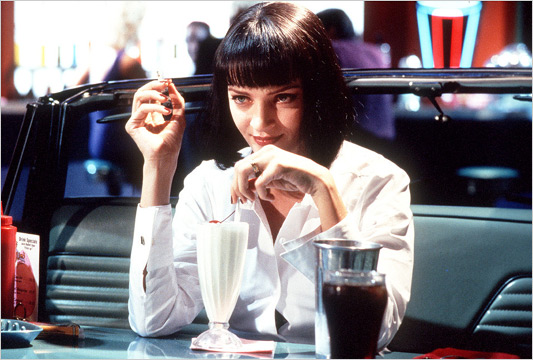
Uma Thurman in "Pulp Fiction" (1994)
ARCHIVE: Readers
may now access
an
Archive of all past newsletters--each annotated--dating back to July,
2003, by simply clicking on www.johnmariani.com/archive
SUBSCRIBE AND
UN-SUBSCRIBE: You may subscribe anyone you wish
to this newsletter--free of charge--by
clicking here.
In
This Issue
The Glory That Is Still French Haute
Cuisine by John Mariani
NEW YORK CORNER:
TWO STEAKHOUSES, OLD AND NEW by John Mariani
Notes from the Wine Cellar:
Santa Barbara Wines by Brian Freedman
QUICK BYTES
~~~~~~~~~~~~~~~
The
Glory That Is Still French
Haute Cuisine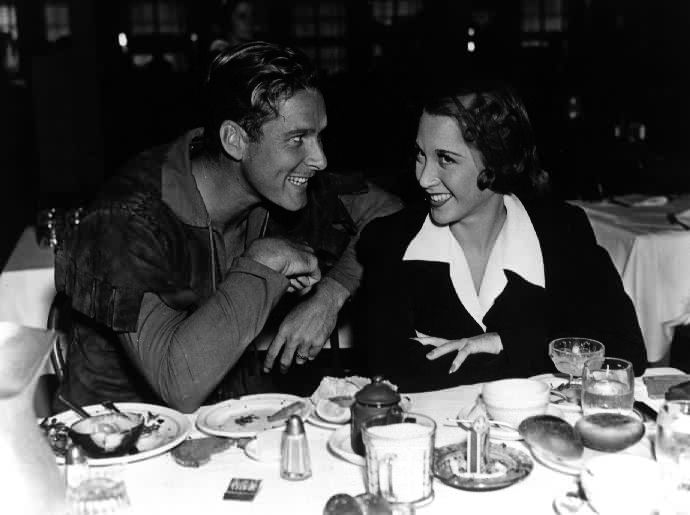
by John Mariani
Luxury, as recently as six months ago considered a goal to be worked for, is now considered something of a greedy vice. And there are a lot more people than Bernie Madoff who should be behind bars taking their meals through a slot rather than staying at posh suites in Paris and dining on haute cuisine.
But for the rest of us who have nothing to feel guilty about and still want to experience the glory that is still very much a factor of luxury in Paris, there are ample ways to achieve it. Needless to say, the grand châteaux-style hotels have been losing large chunks of business, especially Americans, so they are working on deals both for rooms and for their restaurants, making them all the more attractive. Don't ever accept the posted rate or the first rate you get from the booking agent!
Last month I dined at three superlative, Michelin-starred hotel restaurants in Paris, and the results were tremendously impressive. For as much as I adore the smaller, lesser lights of Parisian gastronomy (click here to see last week's newsletter on bistro dining), to put yourself in the hands of a service staff and kitchen designed in every way to make you feel special is still among the great gifts of civilized living.
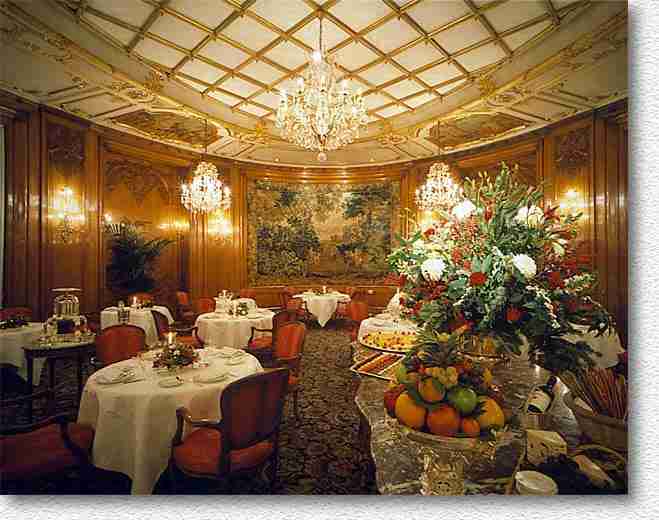 Restaurant
D'Hiver
Restaurant
D'Hiver
Le Bristol Hôtel
112 Rue du Faubourg Saint-Honoré
011-33-(0)-1-53-434334
www.lebristolparis.com
Classic
in the Beaux Arts style with flourishes in every
square inch, D'Hiver (winter) dining room at Le Bristol
Hôtel is
certainly one of the most romantic of venues if you fancy yourself a
Louis Jourdan type out of "Gigi." In the warmer weather you may
dine
overlooking or in the hotel gardens at the Restaurant d'Eté (below). D'Hiver is a
marvel of polished oak
paneling, gilt, crystal, tapestries, and marble; merely entering
the room
through tall French doors brings you into a world where all
seems to be brought to a state of evergreen gentility.
The
Bristol property itself dates to
1757 and as a
hotel to 1925, and its recent renovation and enlargement
has
brought an even finer degree of comfort than before, its public rooms
gleaming, its interior swimming pool glowing with rising steam. The bar
lounge here is one of the most sophisticated in town, as delightful for
tea as it is soigné for cocktails. The welcome
is
as cordial as any in Paris, by a young staff, from the reception desk
to the dining room.
Chef Eric Fréchon has now been here for
nearly
a decade, and his cuisine is never less than precise, classic in tone
but not in style, which is entirely his own. I wanted to sample
as many things as possible, so, with two friends in tow, and a glass of
Dom Pérignon 2000 in hand, I dove in, starting with a wild hare
soup with shredded chestnuts and a confit of the meat en civet. A red onion was served carbonara style with a royale of smoked pork fat, black
truffles and girolle
mushrooms, while macaroni came with more black truffles, artichoke and
foie gras and gratin of parmesan--the best mac-and-cheese in Paris. A
bottle of Antoine Foucault Saumur Domaine du Collier 2002 accompanied
these beginnings.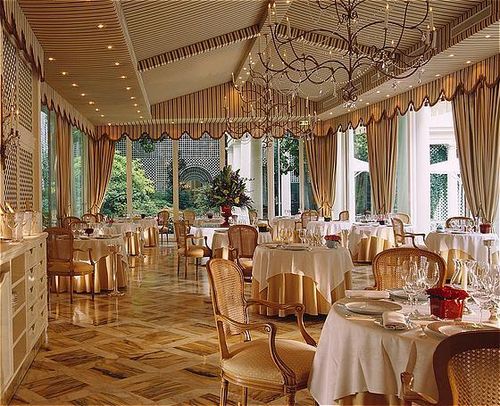
If it sounds somehow like I stepped into
a restaurant italienne, it is
only indicative of how French master chefs have over the last decade
embraced Italian pasta as yet another ingredient for their
palettes. Adding foie gras and black truffles makes it
immediately French in their eyes.
We were back on more Gallic terroir with main
courses like rouget with
roasted eggplant with bright yellow zucchini
flowers and the juice of yellow peppers and a touch of argan oil.
Venison, nice and gamy, was scented with juniper and accompanied by
cannelloni with black truffles, dried fruits, and sweet potatoes with
foie gras in a classic sauce Grand
Veneur--a helluva a hefty dish full of complementary flavors and
textures. Rack and crown of lamb came with a puree of cumin-laced
chickpeas and candied shoulder confit. With all these countervailing
tastes a simple red from the Hautes Côtes de Nuits was wholly
appropriate.
For dessert we enjoyed lichee in a meringue
"snow" with rosewater, pepper and citron, and a splendid ending of oozy
chocolate cake and crispy tuiles
cookies.
The restaurant has a cache of
more than 30,000
bottles and a thousand selections. Menus are printed in various
languages, and, of course, taxes and service are included in the price
of the food. At lunch there is a seasonal 95€ menu,
appetizers run 77€ - 80€ and main courses 77€-94€. A 6-course
tasting menu runs 210€, tax and service included, not to mention to
number of little extras, baskets of breads, and mignardises thrown in at front and
end of the meal.
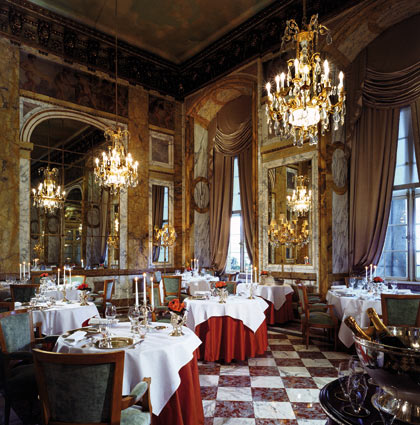 Les
Ambassadeurs
Les
Ambassadeurs
Hôtel de Crillon
10 Place de la Concorde
011-33-(0)-1-44-711-540
www.crillon.com
The
lighting at Les Ambassadeurs at the Crillon is some of the best in the
City of Lights, for this is a room that, without it, could be funereal
in its décor. But the softness of the lighting, and the
way its
reflects on the mirrors and surfaces of marble make everyone in the
room look their best, and there is plenty of light to allow you to see
who is being seated and served.
I don't often put myself wholly in the hands
of the chef even at haute cuisine venues like Les Ambassadeurs, but
since I believe that Chef Jean-François Piège is one of
the very finest chefs in Paris, two friends and I just threw up our
hands and said, "Serve on." The meal we enjoyed over the next three
hours was as creative and wonderful as any I've had--at least since my
last meal at Les Ambassadeurs last year. The beautifully set
tables are the same, including the little flag-like presentations of
the menus, the Champagne and cheese carts are as welcome to behold
as ever, and the service staff, in impeccable English, minister to
everyone's preferences, whether it's for a bottle of
Romanée-Conti or
a Diet Coke. The pretensions of the past in three-star Parisian
restaurants vanished years ago: I was once told back in the 1980s by an
owner of a long-gone two-star restaurant, "Monsieur, a restaurant of
our stature does not descend to serving. . . chicken!" (What a fool!)
Piège (who has authored At the Crillon and at Home, now
available in English) sent out several amuses that included a shredded
carrot salad in lemonade (this was one terrific lemonade); a little
cake of chicken livers with a lobster jus;
crispy fried bread with cod brandade; and a bonbon of truffle
butter in a toasted baguette. Not a bad way to start a meal. These
appetizers were accompanied by a superb François Cotat La Grande
Côte Sancerre 2005.
Next came langoustines done
in a croustillantes style and
as a Japanese maki roll with
golden Iranian caviar, and then blue lobster with crisp slices of
pommes de mer (Irish
potatoes grown near the sea) with smoked salt. In contrast to that
fellow who refused to serve chicken in his restaurant, Piège (below) happily serves chicken
breast from Bresse in a rich cream sauce, with the leg of the chicken,
and
crispy rice lavished with a benediction of white truffles.
Accompanying the main courses was a Philippe Charlopin Parizot Gevrey
Chambertin Bel Air 2003.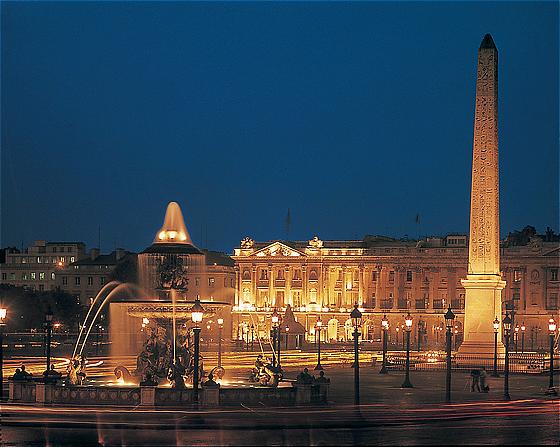
These wonders were followed by various cheese
of the moment and then a vacherin with
wild strawberries, rose and lichee--not to mention a fantasy array of
chocolates, bons bons, candies, and cookies to finish.
What distinguishes such food from
simpler genres of French cuisine is the immaculate care taken with it
by a kitchen staff that numbers twenty or more, devoted to serving only
about 50 guests per night. You could look for an imperfection in the
edge of a macaroon or pause to see if the rice was overcooked by only a
second or the brandade was a
tad salty, but you won't find such tiny errors in this kind of
cooking. Piège, like Fréchon above and
Légendre below, is
one of those chefs who stays put in his kitchen night after night, not
just as a check on perfection but out of pride for his profession--a
dedication many other of their globally-invested colleagues shrug at.
I, for one, believe
such dedication shows in every
dish.
Le Crillon
from the Place de la Concorde
One off note: Les
Ambassadeurs has
thrown in the towel on requesting gentlemen to wear even a jacket for
dinner. For while most men in the dining room that night wore
jackets and ties, one table of six people, including members of the
aging R&B group Kool & the Gang, wore brightly colored sweat
suits and sports jerseys. It was nothing less than a shock seeing
them in such a gorgeous room, where most men still are wary enough to
dress in a way that pleases their women and fits into the ambiance.
The average cost of a 4-course
à la carte dinner (with cheese and dessert) at Les Ambassadeurs
is about 250€; the dinner I described above cost 320€. That's without
wine, but with service and tax. It's a great deal of money for a great
deal of exquisite food, unique in Paris or anywhere else.
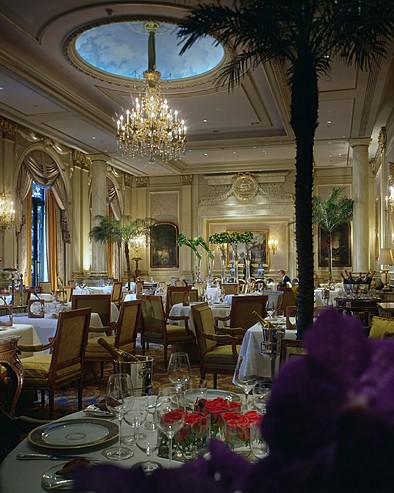 Le Cinq
Le Cinq
Four Seasons Georges V
31 Avenue George V
011- 33 (0)- 1 49 52 70 00
www.fourseasons.com/paris
The
rehabilitation several years
ago of this dowager of a hotel resulted in its becoming the most
contemporary of the grand hotels in Paris. Though the neo-classic and
19th century lineaments are all of museum quality, lighting, again,
makes all the difference, and the George V positively emanates light in
every room, from the sunny (when there's sun in Paris) wide lobby (below) through the
hallways and into the dining room Le Cinq. There are flowers
everywhere.
Le Cinq's wine cellar is not only
vast but among the best collections of both new and older vintages, in
excess of 1,500 selections and 50,000 bottles. Ask
to visit (by elevator) the cellar, once
part of an old stone quarry used to build the Arc de Triomphe. In World
War II the cellar was walled up to protect its bottles from falling
into German
hands.
Last year Chef Eric Briffard, previously at Les Elysees du Vernet and
before that at Jamin, replaced Le Cinq's original chef, Philippe
Légendre, and has shown a more forward-looking style but one
that is still in the very juch in themode of the Hotel's haute cuisine
standard. You taste it--and see it--in beautiful
presentations like his
langoustines browned with hazelnut and rosemary and served with apples
sautéed in salt butter. Crab is dressed with a cream of "jaune" (yellow wine) and daikon
turnips
marinated in spiced honey, while abalone from
the Brittany sea takes on Pacific overtures in a hen broth with
kabocha-flavored ginger meuniere
style.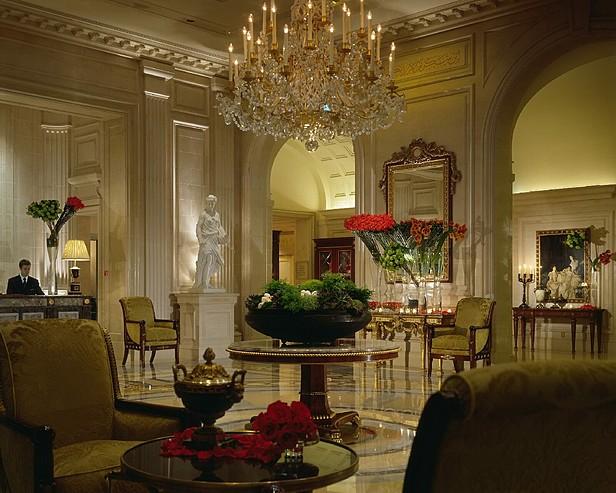
There is some ginger also in the main course of
suckling pig done teriyaki style with bok choy, and I applaud
Briffard's use of lamb shoulder--a lesser cut once unthinkable
in an
haute cuisine restaurant!--with aromatic spices, the peppery North
African harissa,
and dried fruits, all done tagine
style. If you prefer fish, the
fillet of wild turbot with wasabi sauce, shellfish, and potatoes with
seaweed shows just how daringly spicy he is willing to go. It is this
openness to international ingredients and techniques, always based on
obtaining the best from the market, is what has transformed Parisian
dining in this century without in any way compromising the structure of
classic French precision and refined taste.
Desserts at Le Cinq revert to more traditional
French style, for nothing done at the end of a meal in Asia, Africa, or
the Middle East can match
what the French perfected decades ago.
Now the bill: Le Cinq is very expensive:
Appetizers run 62€-$128€ and main courses 75€-115€. The simplest
way to assess those figures is that you get what you pay for here in
sheer elegance, service, and exquisite food.
~~~~~~~~~~~~~~~~~~~~~
NEW
YORK CORNER
TWO
STEAKHOUSES, OLD AND NEW
by John Mariani
Only a decade
ago the look and ambiance of the New York
steakhouse--which set the standard for all those now proliferating
around the U.S.A.--was almost embarrassingly the same: Yellowed walls
with dark wood wainscoting, manly artifacts and caricatures on the
walls, and waiters who all wore the same beige jackets, black
trousers, white shirts, and black ties. Today, only a few of the
oldtimers
hold to that look, while newcomers, who usually work without the same
menu format as their competitors, have tried hard to distinguish
themselves from the New York clones across the street. One of the first
to break the old mold is now
eight years old, Strip House;
a newcomer, Union Prime, takes
décor to a colorful new
level that is a riot of flowered wallpaper. Both serve damn good
American food.
STRIP HOUSE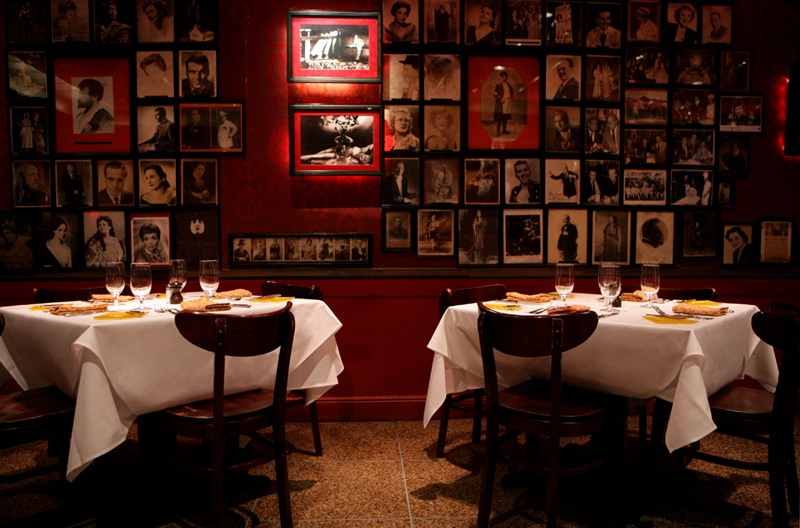
13 E 12th
Street (near Fifth Avenue)
212-328-0000
www.striphouse.net
Penny and Peter Glazier now have seven
branches of this very popular steakhouse, but, of course, New York's
was
the first, the template, the proving grounds. The racy name Strip
House is backed up with a décor of
lipstick red walls and show biz photos focused on black-and-white
burlesque queens of the '30s, '40s, and '50s. When Strip House opened,
no one was sure how such risqué wall hangings would be accepted,
unless
all the patrons were male. But the décor that once proved
to be a
hoot has now acquired a wonderfully nostalgic sense of a vanished era
in NYC show biz history. It's really fun to be part of it.
Any consideration of a NYC steakhouse
begins with the quality of the beef, because over the
years of steakhouse proliferation, USDA Prime--the quality only the
best NYC steakhouses once used--has been degraded to the point where
what used to be called Top Choice (still a very good grade) is now
allowed to be marked Prime. The rich marbling that once defined
Prime is no longer what it was, unless you go to the best NYC
steakhouses like Palm, Peter Luger, Smith & Wollensky, and Ben
Benson's. I certainly include Strip House in this firmament, for its
beef has all the intra-muscular fat and aged mineral flavor that you
could want. You won't find that in a lot of the steak chains' lockers,
not even in many of the NYC originals' branches.
That said, I haven't had a better
bone-in ribeye in NYC than the one I was served at Strip House--a
massive 22-ounce cut for two and a steal at $44--oozing succulence, al dente (if you will) in texture,
and as good close to the bone as on the outer rind of trimmed fat. One
of the distinguishing marks of Strip House's cooking--and only a few
steakhouses take the time to do it--is that they let all their steaks
rest for 5-10 minutes before serving, allowing the juices to
stabilize. The technique is in every cookbook, but with volume
cooking in steakhouse kitchens, this step is often forgotten. It makes
a big difference.
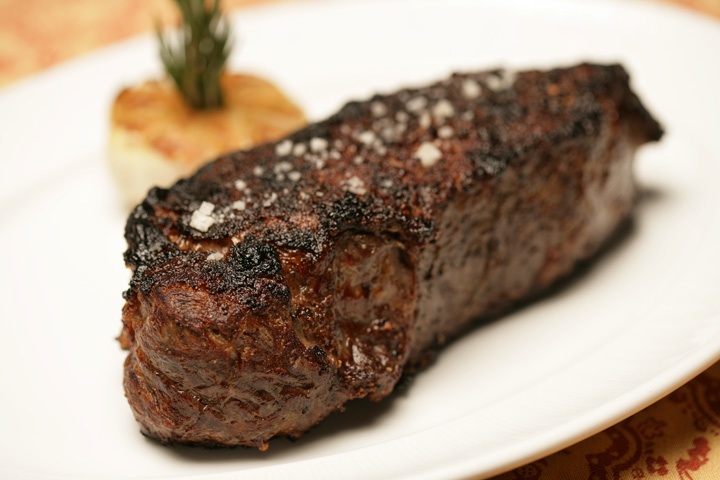 Strip
House also serves New York strip (below),
filet mignon, chateaubriand and a 40-ounce porterhouse, along with veal
t-bone, Colorado rack of lamb, and lobsters that top out around three
pounds.
Strip
House also serves New York strip (below),
filet mignon, chateaubriand and a 40-ounce porterhouse, along with veal
t-bone, Colorado rack of lamb, and lobsters that top out around three
pounds.
Another distinguishing mark
of Strip House upon opening was a wider range of appetizers
than the three or four most competitors always offer. So, in
addition to jumbo shrimp, good meaty crabcake, and Caesar salad, they
feature sea scallops with a succotash of edamame beans, black truffle
butter and sweet corn broth. Don't miss the warm garlic bread
lavished with a Gorgonzola fondue, one of the Glaziers' signature items
in all its restaurants, or the foie gras torchon. Their great addition
to side order menus was the potatoes slices fried in goose fat, and
the fried onions are addictive and sweet. Creamed corn with
pancetta is another item you won't find easily elsewhere.
For dessert go with the house
cheesecake, not the chocolate cake or brownie, which need work,
starting with better chocolate and more butter.
Strip House has over the
years built up a considerable and apt winelist, heavy in reds and
chardonnays, though I hope, in this economy, they will bring in more
bottles under $50.
So, you get great beef
here. Then add in the rest of a diverse menu, responsive service,
and the sideshow of the décor, and you've got something just
enough out
of the ordinary to make you want to adopt Strip House as the place you
want to take your out-of-town friends to show them what they just can't
get out of town, unless there's a branch in that town they came from.
Appetizers run $8-$19, main
courses $29-$44. Open for dinner nightly.
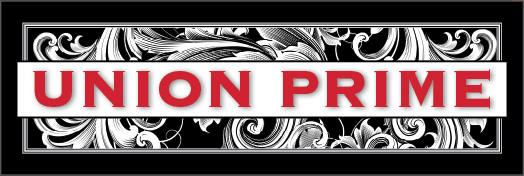
9 East
16th Street (near Fifth Avenue)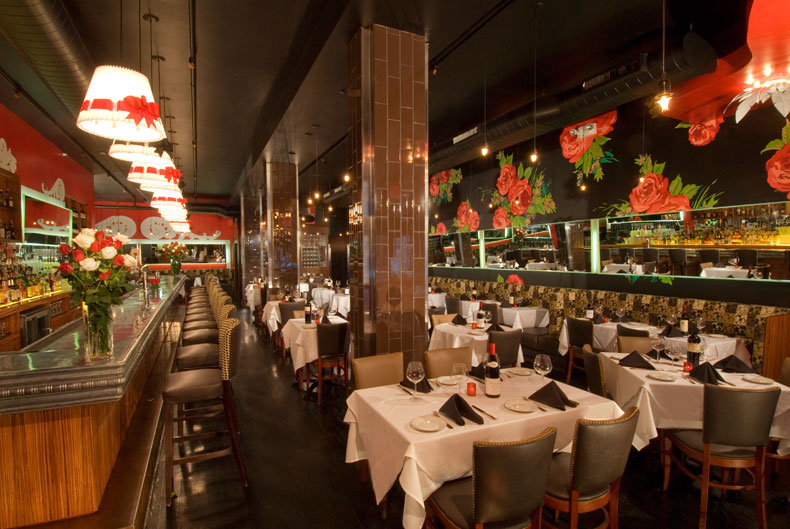
212-675-4700
www.unionprimenyc.com
These
premises used to be Steak Frites (since moved to West Green Village),
then an unlamented place called Café Society. Now, as
Union Prime,
the interior has taken on a unique look for a steakhouse, via designer
Carleton
Varney, whose flamboyant use of color and flowery fabrics has decked
out everything from Ashford Castle in Ireland and the Grand Hotel on
Mackinac Island, Michigan, to The Breakers in Palm Beach and the
Greenbrier in West Virginia. He is the president of NYC's Dorothy
Draper & Co. Inc., the oldest established interior design
firm in the United States, and author of a book entitled Kiss the Hibiscus Good Night.
None of which seems to have much at all to do with
the traditional masculine atmosphere of a New York steakhouse, but
Varney has been very careful to modulate his floral posh with the solid
panache of a good shiny steel bar, and sturdy, comfortable
banquettes. Maybe the girlie red bows on the hanging lampshades
should go?
Chef Brady Duhame (below) is a big guy with a generous
hand, and he selects the best ingredients he can find, having worked at
demanding kitchens like Bouley, Picholine, and Park Avenue
Café. The beef is USDA Prime from good sources, though the
"21 Day
Dry-Aged Porterhouse for Two" (40-ounces at $66.95) is actually shipped
in wet aged, then dry aged further on premises. In any case, it's very
good beef and Duhame knows how to cook it right, with a good char on
the outside and medium-rare (as ordered) inside. I have been assured
that the Australian lamb recently on the menu has now been replaced by
first-rate Colorado lamb.
Here the appetizers roam beyond the
predictable, with a yellowfin tuna tartare, a fine fat Maryland
crabcake, impeccably fried calamari and artichokes drizzled
with a lemon-fennel aïoli (terrific dish!),
and seared beef carpaccio
artfully laid on a platter and drizzled with a truffle emulsion. Then
there are several offerings of sushi rolls--not unique in steakhouses
these days but a pleasing addition. Union Prime's are good in
flavor--try the "fire dragon roll"--if a bit mushy in texture the night
I tried them. If you like sauces with your steak Union
Prime offers Béarnaise,
diablo, horseradish (excellent), and green peppercorn at a fair two
bucks a shot.
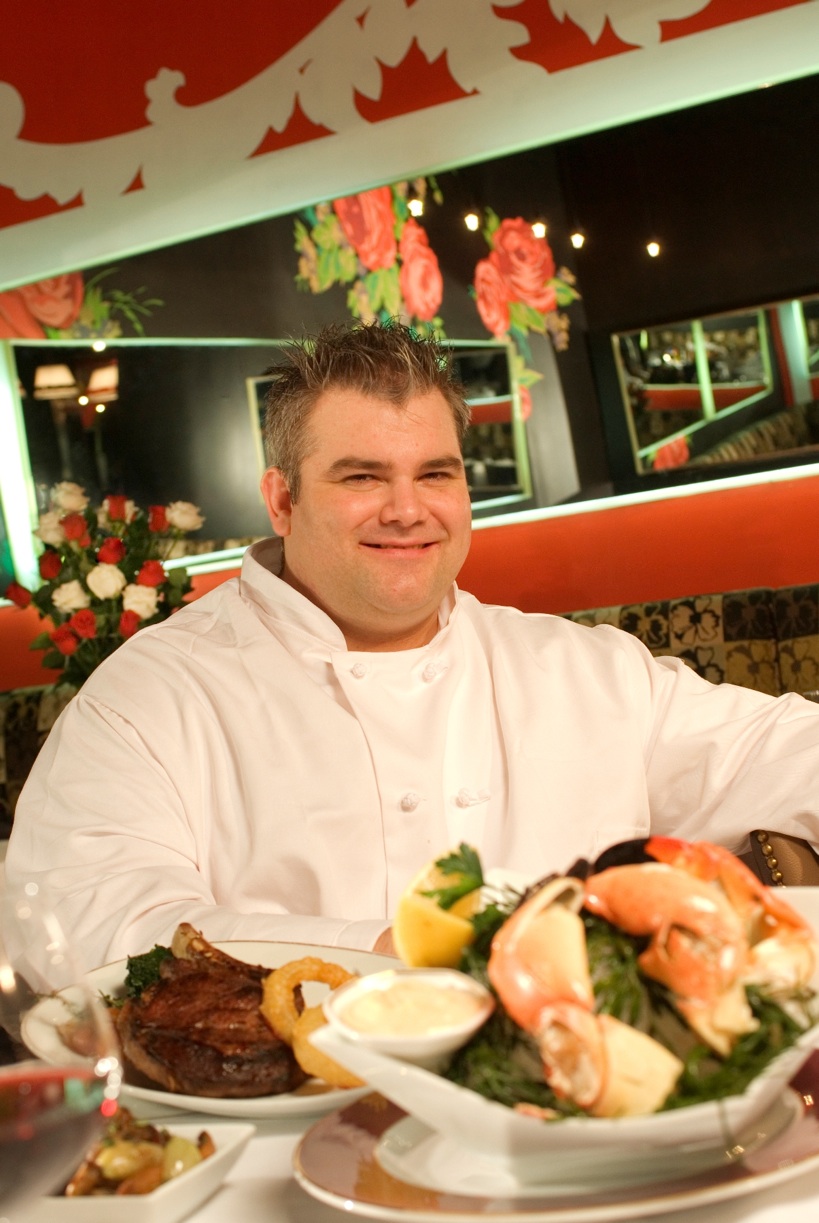 If
you're not in a mood for a good steak, by all means try the
swordfish--a species that is so often less than fresh and too often
mealy in texture; Union Prime's version is first-rate--a very thick
slab impeccably cooked to the juiciest point, the flavor of the sea
still there in all its pristine glory, basted with herbs.
If
you're not in a mood for a good steak, by all means try the
swordfish--a species that is so often less than fresh and too often
mealy in texture; Union Prime's version is first-rate--a very thick
slab impeccably cooked to the juiciest point, the flavor of the sea
still there in all its pristine glory, basted with herbs.
Side orders are very
good--buttery whipped potatoes, bourbon
glazed yams, mashed potatoes studded with lobster meat, and
sensationally rich creamed spinach. The signature item here is
"house-made tater tots," but frankly I found them gimmicky, oily, and
way too salty.
I liked most of the desserts, like
mascarpone cheesecake with quince and a moist devil's food
cake with ganache and raspberry fillings, but although it is early in
the year, I'm betting the ice cream sandwiches with cinnamon ice cream,
whipped cream and raspberry, chocolate, and caramel dipping
sauces--like the best Mallomars you've ever had--will be among my five
best desserts of 2009.
The 200-selection winelist is solid,
though it, too, tends towards the more expensive bottlings, and the bar
prides itself on its unusual cocktails, while making the classics with
true acumen.
Now for the big news at Union Prime: The
steaks here are amazingly moderately priced: Most steakhouses in NYC
charge $40 and up for their beef, but here the center-cut strip steak
is $29.95, the 20-ounce ribeye $34.95, and the 40-ounce porterhouse for
two $66.95--prices that barely pay for the meat at wholesale. I
asked Duhame how they could do this, and he explained that, at least
for the time being, the owners are willing to make just a dollar or two
over cost in these early days of trying to win clientele. Not a bad
idea, but clientele gets very ornery when prices get hiked.
Appetizers run
$9.50-$14.50, other entrees $17.95-$23.95. Open for lunch
Mon.-Fri., Dinner, nightly, Brunch Sat.
& Sun.
NOTES
FROM THE WINE CELLAR
A SIDEWAYS
GLANCE AT SANTA BARBARA
by Brian Freedman
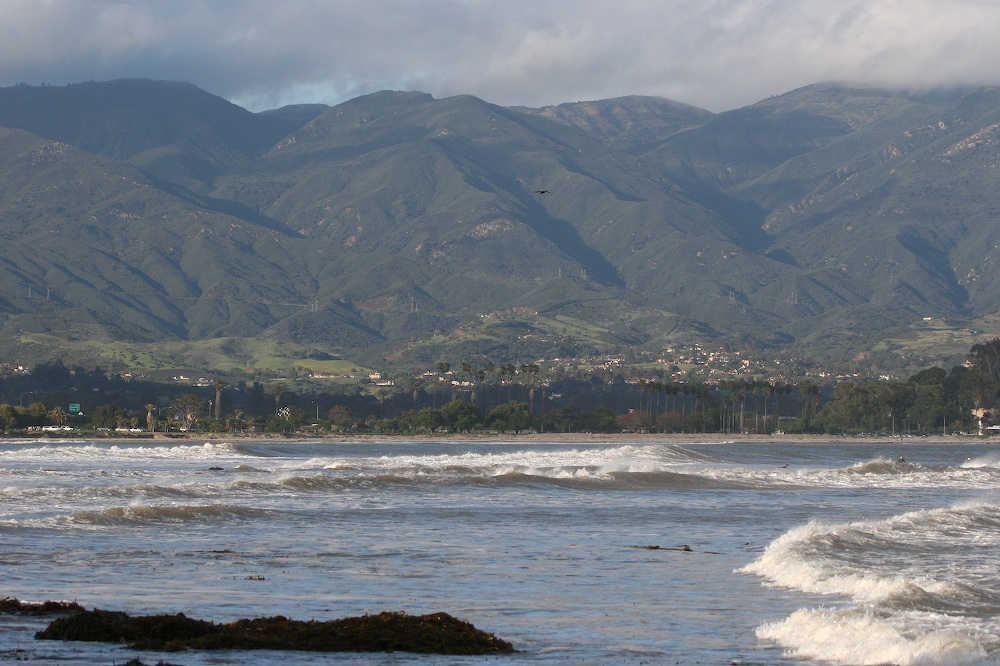 It’s
tempting to think of the wine
world as a firmly codified place. Perhaps no other agricultural
industry is as rigidly regulated, in terms of geographical boundaries,
planting, and production, as wine. French AOC (Appellation d’Originé
Côntrolée) and Italian DOC (Denominazione di Origine
Controllata) law, with varying degrees of specificity and
restrictiveness, deal with everything from the grapes that may be grown
in a specifically demarcated area, to how much fruit can be harvested,
minimum alcohol levels, and more.
It’s
tempting to think of the wine
world as a firmly codified place. Perhaps no other agricultural
industry is as rigidly regulated, in terms of geographical boundaries,
planting, and production, as wine. French AOC (Appellation d’Originé
Côntrolée) and Italian DOC (Denominazione di Origine
Controllata) law, with varying degrees of specificity and
restrictiveness, deal with everything from the grapes that may be grown
in a specifically demarcated area, to how much fruit can be harvested,
minimum alcohol levels, and more.
But on this side of the pond, for
better or worse, there are fewer such nationwide regulations governing
the growth of grapes or the production of wine, aside from a few
cursory rules. And while this occasionally acts as a detriment to the
American wine industry—the meaning of “reserve,” for example, is fuzzy
at best—it is also beneficial in terms of discovering new or unexpected
areas for the production of certain types of wine.
Nowhere, perhaps, is this benefit of
our dearth of national wine laws more apparent than in California’s
Santa Barbara, from which I have recently tasted a number of
remarkable, and, in the case of some of them, remarkably unexpected,
bottles. For most California wine lovers, Santa
Barbara, and, specifically, Santa Maria, Santa Rita Hills, and Santa
Ynez, are havens of chardonnay and pinot noir production. Producers
like Au Bon Climat and Bonaccorsi have made their mark on the wine
world with stunning bottlings that express these Burgundian grape
varieties brilliantly. The film "Sideways," (below) in fact, was essentially a
two-hour love letter to Santa Barbara pinot noir—and, I’d argue,
justifiably so.
But to only focus on these grapes, or
on the Rhône Valley varieties that also do so well in Santa
Barbara, would be to miss out on one of the most exciting revolutions
underway in the world of American wine. For these days,
Santa Barbara is
finding its inner Bordelais alongside its more Rhône-y and
Burgundian tendencies. That’s right: Some 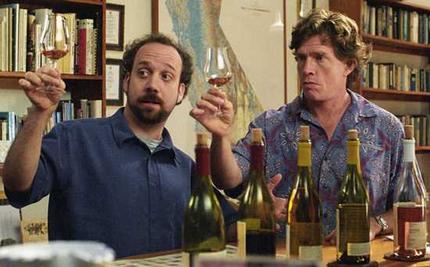 of the most exciting
cabernet-based wines coming out of California are being produced there.
And while the Napa Valley is arguably still the beating heart of
American cab production, the quality and relative value of Santa
Barbara’s red Bordeaux-varietal wines is remarkable.
of the most exciting
cabernet-based wines coming out of California are being produced there.
And while the Napa Valley is arguably still the beating heart of
American cab production, the quality and relative value of Santa
Barbara’s red Bordeaux-varietal wines is remarkable.
One of the shining stars of this brave
new world of Santa Barbara cabernet production is Nick de Luca,
winemaker for Star Lane and Dierberg Vineyards. He is the man
responsible for one of the most exciting California reds I’ve tasted in
the past year, and the one that opened my eyes to the potential of that
grape in that part of the state: The
Star Lane Vineyard “Astral”
Cabernet Sauvignon 2005.
The first vintage of this standout
wine, the 2005, was released in August 2007 for $51.89 and embodies
what de Luca told me was “almost a religious faith type of thing” in
the potential of Santa Ynez cab. A barrel sample I tasted was an
ink-colored blockbuster with a rich, perfumed nose of wild flowers,
sweet berries, and chocolate. It tasted of super-ripe red and black
berry fruit, coffee, and cocoa. A bottle of the Astral that I tasted at
the winery showed similar characteristics, though with the time it had
to settle down a bit, there were added notes of chocolate-coated green
bell pepper, testament not only to good work in the winery, but also to
smart, judicious vineyard practices, too. You could certainly enjoy it
now—though I'd decant it for an hour or so—but it also has the stuffing
to last for years in the cellar.
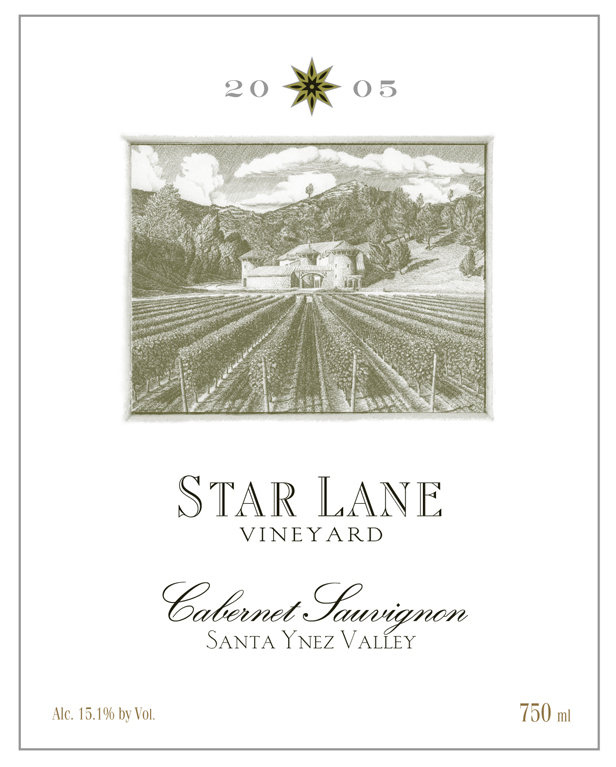 Star Lane
also crafted a winner with
their 2005 Cabernet Sauvignon, another $50 bottle whose deep well of
ripe, sweet fruit embodies everything that wine lovers associate with
top-quality modern California cab: Lovely currants, yes, but also
freshness, minerality, and cedar added to the mix for both complexity
and detail.
Star Lane
also crafted a winner with
their 2005 Cabernet Sauvignon, another $50 bottle whose deep well of
ripe, sweet fruit embodies everything that wine lovers associate with
top-quality modern California cab: Lovely currants, yes, but also
freshness, minerality, and cedar added to the mix for both complexity
and detail.
And, as perhaps should be expected
from this Santa Barbara producer, their Rhône varieties fared
well, too. Dierberg’s 2005 Syrah
reminded me of some sort of perfumed
beef jerky in its juxtaposition of aromas both primal and pretty, the
smoke and mesquite mingling with grilled rosemary and licorice. That
same masculinity is reflected in
the Dierberg 2005 Pinot Noir,
a dense, dark berry-rich wine with
beguiling hints of thyme and mushrooms on the palate and a long finish
redolent of leather and moist underbrush.
These days, Santa Barbara is
chock-full of great producers who are excelling with a far wider range
of grape varieties and styles than the area typically gets credit for.
Indeed, as the wine world expands and shifts, smart collectors will
remain open-minded when it comes to deciding where their wines come
from. Because the old assumptions are not only being challenged, but
turned on their heads with every cork that’s popped. Santa Barbara is a
great example of this, and a delicious one at that.
Ah, the Koreans were eatin'
tasty little pups when
you Scots was still paintin' yer damn faces blue
"Wouldn’t you just know that the world centre of excellence for dog
cloning is South Korea. Of course it is. Where else would it be, in a
world that patently works as a manga version of Grimm’s fairy tales?
Naturally, the Koreans clone dogs. They have two laboratories competing
to corner the market in copycat dogs. One is led by Hwang Woo-suk (the
h is silent), a disgraced scientist who’s been tried for fraud, the
other by his protegé, Lee Byeong-chun, who has, surprise,
surprise, also been accused of fraud. It’s plainly obvious that clones
breed clones and that fraud breeds fraud and, anyway, what else would
cloners be guilty of except duplicity. Apparently, the Roslin Institute
in Scotland is pissed off at the Koreans for cloning their patented
cloning technology. No. You do sheep. We do dog. Scot person eat
disgusting haggis from sheep arse. Korean eat yummy dog. You sod off
back to fat-battered Gorbals and take your sporran with you.”—A.A.
Gill, “Tendido” Times of
London.
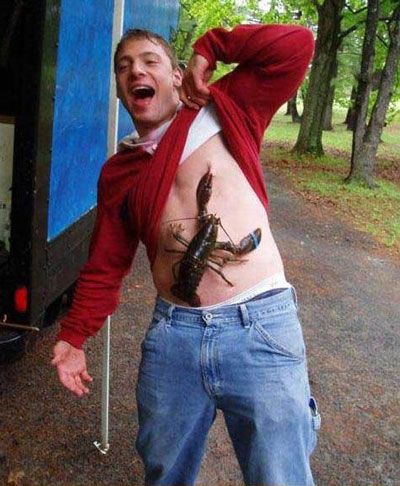 IS
THAT A LOBSTER IN YOUR PANTS OR ARE YOU GLAD TO SEE ME?
IS
THAT A LOBSTER IN YOUR PANTS OR ARE YOU GLAD TO SEE ME?
A San Diego man named Binh Quang Chau allegedly poaching lobsters was caught
with six of them stuffed down his pants. He allegedly took the
lobsters from the La Jolla State Marine Conservation Area, and
Department of Fish and Game warden Daryl Simmons says wardens arrested
Chau when they noticed "odd bulges" in his pants.
To all public relations people: Owing to the amount of press releases regarding Valentine's Day dinners, I regret that it is impossible to list any but very special events.
* On Jan. 27 Del
Frisco’s Double Eagle Steak House in Houston will pair with Paul
Hobbs Winery for a wine dinner. Sommelier Jaffer Kovic and Hobbs will
introduce guests to 5 wines with Chef Steve Haug’s cuisine. Call
713-355-2600. $165 pp. Call 713-355-2600;
http://www.paulhobbs.com.
* On Jan. 28 in Venice, CA, Piccolo presents
its “8a Cena al Contrario Black Truffle Edition” (8th reversal wine
dinner). because instead of you choosing first the food and
then the wine, you’ll choose the wine first, and Picciol
chef Riberto Ivan will pair it with the food. For one night a
month, guests may choose and taste three or five glasses of
wines, among 30, chosen by sommelier Pietro Biondi. $70 pp for 3
courses; $110 for 5. Call 310-314-3222; http://www.piccolocipriani.com.
* From Jan. 28-31 in Beaver Creek, CO, Beaver Creek Resort and Bon Appétit magazine, hold
the Bon Appétit Culinary & Wine Focus, incl. “Supreme”
Entertainment Live Concert with Mary Wilson of the Supremes; Cooking
Classes, Wine and Spirits Seminars; Subaru Snowshoe Excursion and
Luncheon; Celebrity Chef Ski Race and Awards Luncheon; Culinary
Showcases; Grand Tasting. Visit www.bonappetitfocus.com or call
888-920-2787.
* From Jan. 30-Feb. 1, The Oregon
Truffle Festival
features a Cultivation Seminar, Truffle Growers’ Forum, a Truffle
Marketplace, and truffle cooking classes, and a Grand Truffle
Dinner at the Valley River Inn on Jan. 31, with 5 of
Oregon’s most celebrated chefs. Visit
www.oregontrufflefestival.com.
* The Grand Del Mar
in San Diego has announced its 2009 Culinary Series calendar, which
kicks off in February with a “Strickly Stag” Valentine’s Day cooking
class for guys. The series features monthly 2-hour sessions led by the
team at The Grand Del Mar, incl. Chef William Bradley of Addison and
Wine Director Jesse Rodriguez. Call 858-314-2000. The
complete Culinary Series calendar is available at www.thegranddelmar.com
* Beginning in February in San Francisco, Chez Papa Resto will be offering a
monthly changing themed 4-course menu at $50 pp by Chef David
Bazirgan. Visit chezpapasf.com or email to
chezpapadining@yahoo.com.
* In NYC Bar Boulud will
be holding informal Saturday wine events with a themed selection of
8-10 wines and charcuterie. Feb. 7: Wines of Maison Remoissenet
Pere et Fils with Pierre Antoine Rovani; Feb. 21: Wines from the
Loire Valley with Kurt Eckert; $75 pp. Call 212-595-1313 x152.
* On Feb. 7 Rodney
Strong Vineyards presents its 20th Annual Wine & Chocolate
Fantasy in Healdsburg, CA, for $40 pp. Radio personality Ziggy the Wine
Gal will emcee and Earl Thomas will provide rhythm and blues. Visit
www.rodneystrong.com.
* On Feb. 7, Silver Oak
Cellars is holding simultaneous "Release Day" events at its
Oakville and Geyserville, CA, wineries to celebrate both the
Grand Opening of its new Oakville winery and the release of the 2004
Napa Valley Cabernet Sauvignon, with foods prepared by wine country
chefs (incl. Silver Oak chef Dominic Orsini at Oakville), live music,
bottle signings, library tastings and plenty of wine. $30
pp. Call 800-273-8809 or visit www.silveroak.com.
* In Feb. 9 in New Orleans, Galatoire’s will hold The 2009
Mardi Gras Auction with a reception featuring Champagne Mandois,
sponsored by Partners Wine, and hors d’oeuvres by Chef Brian Landry.
Bids at $150 per seat for dining, with proceeds to the Animal Rescue of
New Orleans and the International Shrine of St. Jude, Our Lady of
Guadalupe Church. Call 504-525-2021 or visit www.galatoires.com.
* On Feb. 9 in NYC, in celebration of its 10th
Anniversary, Tabla and
Executive Chef Floyd Cardoz will host the Third New Indian Dinner to
benefit Pratham USA, with a 6-course dinner and reception
prepared by a some of NYC’s leading chefs: Dan Barber, Blue Hill
& Blue Hill at Stone Barns; David Chang, Momofuku ;
Michael Romano, Union Square Cafe ; Marcus Samuelsson, Aquavit ;
Melissa Walnock, Pastry Chef, Tabla . $300 pp and sponsorship packages
of up to $15,000 are available for presenters. Call Caterina
Stabile: 646-747-6616; cstabile@tablany.com.
* On Feb. 13 Waterman
Gril in Providence, RI, holds a “French Connection Wine
Dinner” with selections from 3 French vineyards paired with Chef
Michael Conetta’s 4-course menu. On hand to lead the tour will be
Nicolas Potel of Burgundy, Stéphane Aviron of Potel-Aviron in
Beaujolais, and Antoine Vincent from Chateau Fuissé and JJ
Vincent in Burgundy. $89 pp. Call 401-521-9229 or visit
www.watermangrille.com.
* The Willamette Valley
Wineries Association (WVWA) joins the Oregon 150 celebration as
an official partner to promote 150 Days of Wine in the Willamette
Valley, a series of wine events and activities taking place between
Feb. 14 and Labor Day weekend in all Agricultural Viticulture Areas
(AVA’s). For a listing of the wine events, please visit
www.willamettewines.com.
* Spruce in San
Francisco announces its yearlong winemaker dinner series, one weeknight
per month throughout 2009, each to feature a 5-course tasting menu
prepared by Chef Mark Sullivan alongside wine pairings selected by that
evening’s guest winemaker. All dinners will range from $100 -
$200. For schedule call 415-931-5100.
* On Feb. 14 & 15, the family wineries of the Madera Wine Trail in California
will host “Wine
& Chocolate Weekend.” Wine lovers may purchase a $20 Passport Wine
Glass at any of the participating wineries both days of the
event. Guests will sample current and newly released vintages and
chocolate creations, special food pairings, local art and live music.
Call 800-613-0709.
* Winter weeknights at the Inn at Perry Cabin in
St. Michael’s, Maryland now feature limited time offers: Guests booking
the “Three for Two” package receive luxury accommodations for 3
nights at the price of 2. Amenities incl. board games delivered to
guests’ rooms, DVD movie and candlelit turndown service with
cordials in room and a drawn bubble bath. Fresh cookies each night.
Package rates from $630 thru April 2. Also, “Dinner &
Demo Nights” every Wed. thru March 25, with guests enjoying a
tasting of wine while helping Chef Mark Salter prepare the first course
and second and third courses prepared by Chef and served with wine
pairings chosen by the Sommelier. $75 pp or $100 with wine.
Overnight accommodations from $190 per night may be added. Call
1-800-957-6127; www.perrycabin.com.
Everett Potter's Travel Report:

~~~~~~~~~~~~~~~~~~~~~~~~~~~~~~~~~~~~~~~~~~~~~~~~~~~~~~~~~~~~~~~~~~~~~~~~~~
Eating Las Vegas is the new on-line site for Virtual Gourmet contributor John A. Curtas., who since 1995 has been commenting on the Las Vegas food scene and reviewing restaurants for Nevada Public Radio. He is also the restaurant critic for KLAS TV, Channel 8 in Las Vegas, and his past reviews can be accessed at KNPR.org. Click on the logo below to go directly to his site.
~~~~~~~~~~~~~~~~~~~~~~~~~~~~~~~~~~~~~~~~~~~~~~~~~~~~~~~~~~~~~~~~~~~~~~~~~~~
Tennis Resorts Online: A Critical Guide to the World's Best Tennis Resorts and Tennis Camps, published by ROGER COX, who has spent more than two decades writing about tennis travel, including a 17-year stretch for Tennis magazine. He has also written for Arthur Frommer's Budget Travel, New York Magazine, Travel & Leisure, Esquire, Money, USTA Magazine, Men's Journal, and The Robb Report. He has authored two books-The World's Best Tennis Vacations (Stephen Greene Press/Viking Penguin, 1990) and The Best Places to Stay in the Rockies (Houghton Mifflin, 1992 & 1994), and the Melbourne (Australia) chapter to the Wall Street Journal Business Guide to Cities of the Pacific Rim (Fodor's Travel Guides, 1991). THIS WEEK: A Report on The Four Seasons Jackson Hole. Click on the logo below to go to the site.

Family Travel
Forum: The
Family Travel Forum (FTF), whose motto is "Have Kids, Still Travel!",
is dedicated to the ideals, promotion and support of travel with
children. Founded by business professionals John Manton and Kyle
McCarthy with first class travel industry credentials and global family
travel experience, the independent, family-supported FTF will provide
its members with honest, unbiased information, informed advice and
practical tips; all designed to make traveling a rewarding, healthy,
safe, better value and hassle-free experience for adults and children
who journey together. Membership in FTF will lead you to new worlds of
adventure, fun and learning. Join the movement.
All You Need to Know Before You Go
~~~~~~~~~~~~~~~~~~~~~~~~~~~~~~~~~~~~~~~~~~~~~~~~~~~~~~~~~~~~~~~~~~~~~~~~~
MARIANI'S VIRTUAL GOURMET NEWSLETTER is published weekly. Editor/Publisher: John Mariani.
Contributing Writers: Robert Mariani,
John A. Curtas, Edward Brivio, Mort
Hochstein, Suzanne Wright, and Brian Freedman. Contributing
Photographers: Galina Stepanoff-Dargery, Bobby Pirillo. Technical
Advisor: Gerry McLoughlin.
Any of John Mariani's books below
may be ordered from amazon.com by clicking on the cover image.
 My
newest book, written with my brother Robert Mariani, is a memoir of our
years growing up in the My
newest book, written with my brother Robert Mariani, is a memoir of our
years growing up in the For those of you who don't think of the Robert and I think you'll enjoy this very personal look at our --John Mariani |
 |
 |
 |
 |
 |
 |
© copyright John Mariani 2009
